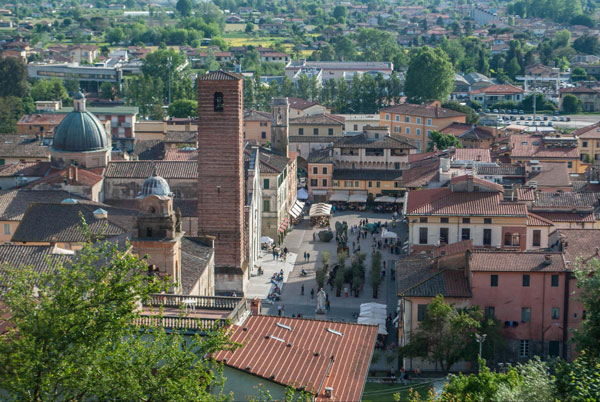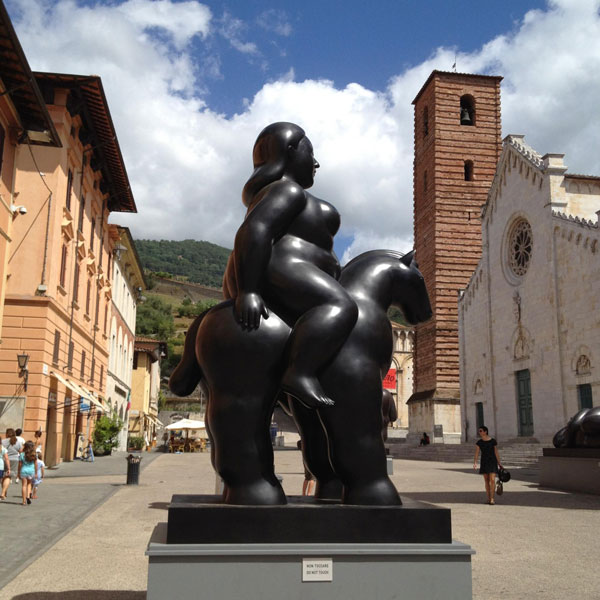A small medieval town with rich art history, Pietrasanta boasts a travel experience like no other–allowing you to get up close and personal with world famous art, monuments, and a centuries old tradition of marble working.
Also known as the Little Athens of Italy, Pietrasanta is where many acclaimed artists call home–Igor Mitoraj, Fernando Botero, and Gina Lollobrigida, to name a few…
The small town is in the beautiful region of Northern Tuscany, with a rich history in the arts and remnants of 15th Century pieces publically displayed throughout the streets. The cobblestone walkways that branch off into delicate courtyards tell the stories of hundreds of years of culture that have passed through them.

(Image Source: www.mytravelintuscany.com)
Nineteenth-century Italian poet Giosuè Carducci, winner of the Nobel Prize for literature in 1906, described Pietrasanta as “a beautiful small city with a singular piazza, a cathedral worth of a great city, all against the background of the Apuan Alps. And what a landscape all around! What a mountain, what a greenery, what a shadow, what a river, what a cool streams running merrily under the chestnuts, olives, and orange trees, and the marble quarries flank the greenery on every side!”
The beauty of Pietrasanta is undeniable, but the vibrancy that exists in the streets today wasn’t always the case.
Roman Origins
A town and commune of Roman origin, Pietrasanta was founded in 1255 by Luca Guiscardo da Pietrasanta upon the “Rocca di Sala” fortress of the Lombards. And, the Roman influence can still be felt today. The straight and narrow streets follow a Roman grid layout, in stark contrast to other Tuscan villages.

(Image Source: www.mytravelintuscany.com)
The first written record of the town was found in the Italian province of Genoa, when it became a part of the province of Lucca. Later, in the 17th and 18th centuries, tragedy hit Pietrasanta in a Malaria outbreak, resulting in Grand Duke Leopold II deciding to build schools and quarries, in hopes to rebuild the deserted town. Little did he know those same marble quarries are what would transform the town into the epicenter of Italian marble sculptures.
Most notably, Michelangelo Buonarroti was the first to recognize the beauty of the fine marble and source it for many of his sculptures out of the quarries of the Apuan Alps.
Pietrasanta, The City of Art
The town eventually reached its artistic peak in the 1970s when the streets were said to be “bursting with artisans covered in marble dust”. Although demand for Pietrasanta’s marble is not what it used to be, the town still hosts an impressive 90 marble studios, six bronze foundries and six mosaic studios–besides other workshops that specialize in printing and ceramics. Many foundries are run by families handing down their skills from generation to generation, and are open to visitors who want to partake in educational tours.

(Image Source: www.mytravelintuscany.com)
Today, the best place for visitors to appreciate the region’s marble is at the Bozzetti Museum in Piazza Duomo. The Bozzetti is the world’s only museum who displays maquettes, the original models of plaster from which sculptures are produced. With over 600 maquettes on display, they even feature Cesar Baldaccini’s famous sculpture, ‘Le Pouce’.
What’s interesting about the maquettes is that often, the original artist, only produced the maquette itself. Later, a separate artisan carves the sculpture and scales it to the artist’s desired size.

(Image Source: www.artislimited.wordpress.com)
Many artists who have called Pietrasanta home, later donated their art to the city. Meaning today’s quaint market streets and high rise architectural buildings are met with centuries old sculptures dotted throughout the streets. Walking through Pietrasanta is like stepping into a open-air museum.
Fernando Botero, Colombian figurative artist and sculptor, also owns a home in Pietrasanta. His signature “Boterismo” sculptures which depict large figures in exaggerated sizes can be seen on display in many parts of the town.

(Image source: www.arlenegibbsdecor.com)
There is no shortage of places to appreciate quality art. In galleries such as the Galleria La Subbia and Galleria Tega, you can see the modern works of artists such as Sandro Chia, Christo and Jeanne-Claude.
Beyond Art Lies Sandy Beaches
However, art galleries are not the only thing that Pietrasanta offers its visitors. You can take a pleasant walk with panoramic views up the hill to the Rocca di Sala and Guinigi Tower and sneak the most mesmerizing view of the city center until the surroundings that kiss the sea.

(Image Source: www.booking.com)
What’s more, the sandy beaches of Marina di Pietrasanta, located only a mile away from town, are virtually undiscovered by foreigners. Between Viareggio and Pisa, Marina di Pietrasanta has huge expanses of beach which stretch out for five kilometers along the coast. The wide stretches of beach are a great advantage because they never feel overcrowded, even in the peak of summer, where you can enjoy relaxing days on the beach without feeling packed in like a sardine.
This makes the Marina di Pietrasanta an ideal place for Florentines and Milanese to flock to for weekend getaways, while enjoying the recent slew of stylish restaurants, boutiques and hotels. Albergo Pietrasanta is one such intimate boutique hotel that even hosts its own private art collection.

(Image Source: www.mirageversilia.it)
Pietrasanta’s proximity to popular beach town Forte dei Marmi also makes it a prime location. The pristine beach town attracts swarms of upper class Italian tourists and tourists from all over Europe. This is because Fortei dei Marmi provides a peaceful environment, surrounded by beautiful pinewood and a sandy beach, making it ideal for biking, sunbathing and leisurely shopping.

(Image source: www.gites.fr)
There’s no doubt that Pietrasanta is a unique Tuscan village, giving visitors a rare glimpse into the marble working artisans who hand-carved the world’s most famous Italian sculptures. And, despite the crowds of Italian vacationers who flock to the city, the seaside community successfully maintains its small village character–striking the perfect balance between past and present.
